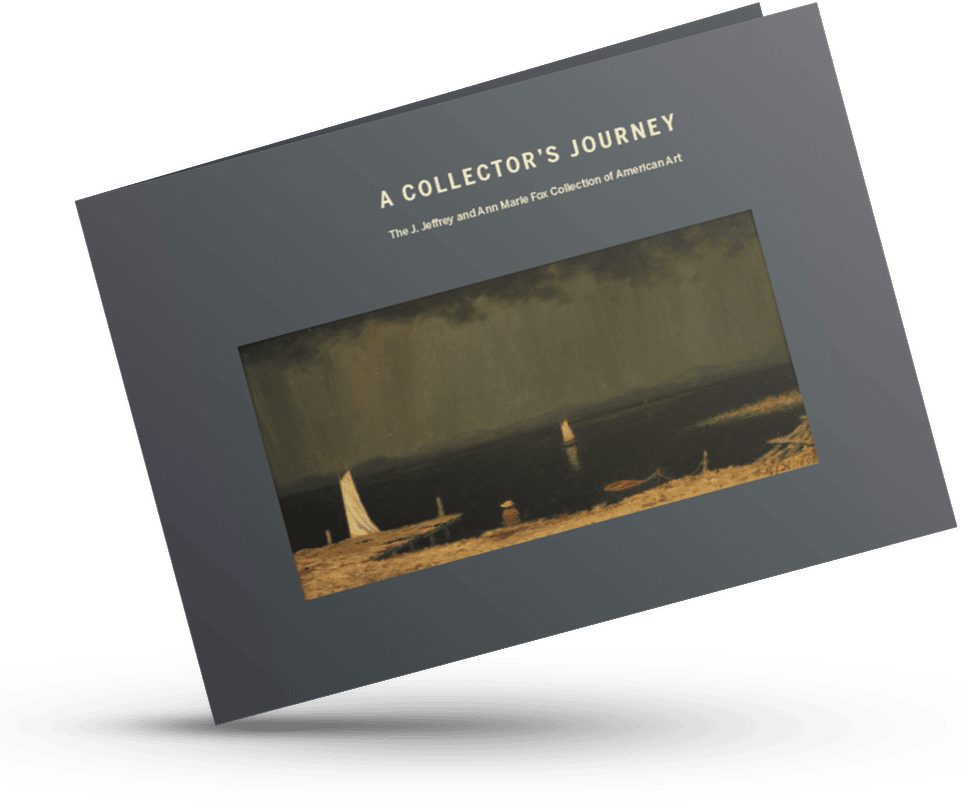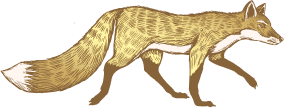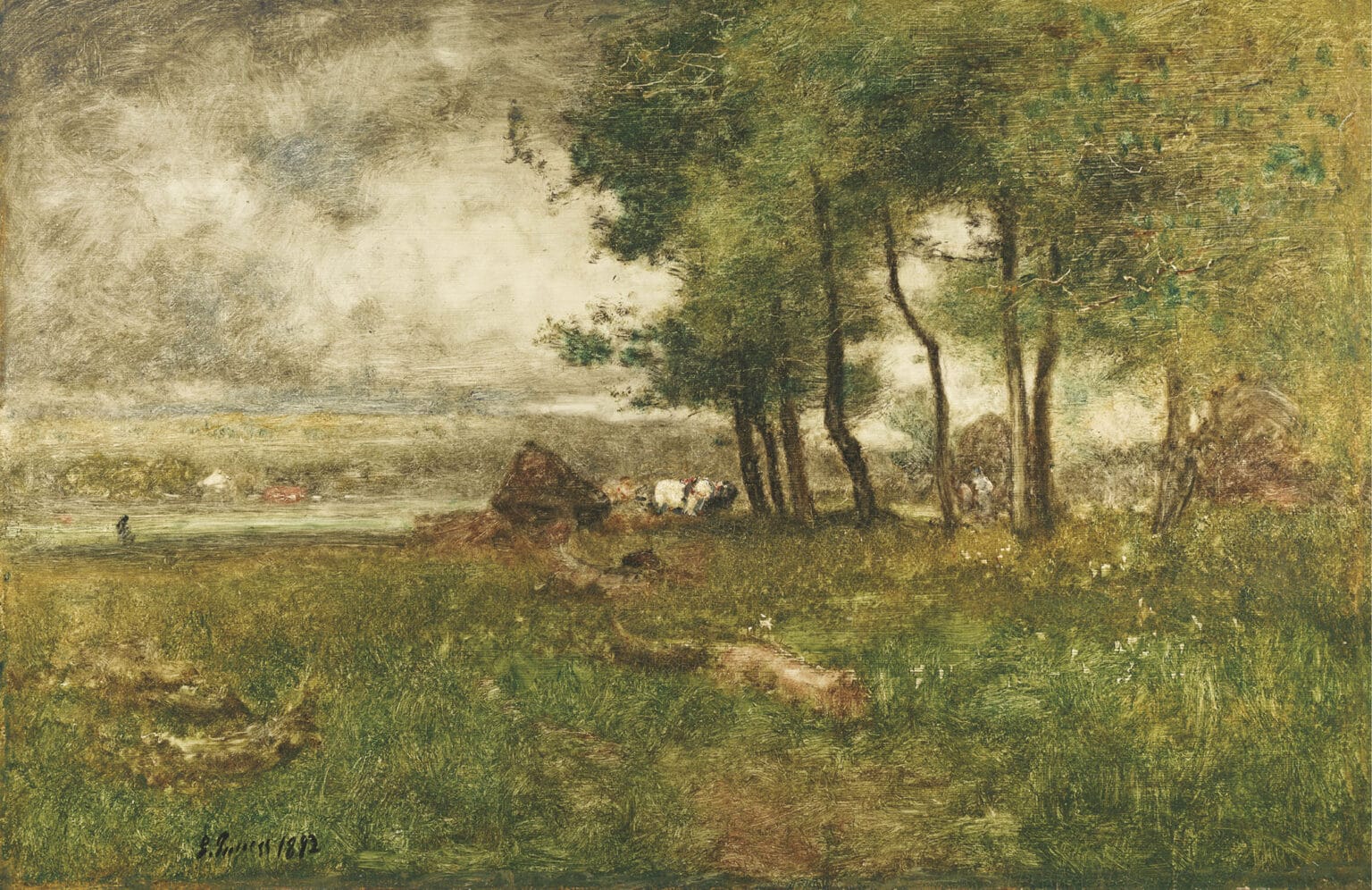George Inness (1825–1894)
Étretat, Normandy, France, 1892
-
Oil on canvas
-
29 ⅞ x 45 inches
-
Signed and dated lower left: G. Inness 1892; inscribed on verso label: No. 33 Etretat Normandy, 1892 30 x 45
Provenance
- Estate of the artist
- Sale, Fifth Avenue Art Galleries, New York, New York, February 12–14, 1895
- Collection of Louis Ettlinger, New York, acquired from above
- Private collection, by descent from the above
- Sale, Christie’s, New York, New York, November 29, 2000, lot 61
- Private collection, New York
- Michael Altman Fine Art & Advisory Services, New York, New York
- Questroyal Fine Art, LLC, New York, New York, acquired from above, 2011
- Private collection, Maryland, acquired from above, 2013
- Questroyal Fine Art, LLC, New York, New York, acquired from above, 2018
- Collection of J. Jeffrey and Ann Marie Fox, acquired from above
Exhibited
Exhibition of the Paintings Left by the Late George Inness, American Fine Arts Society, New York, New York, December 27, 1894
Paintings by the Late George Inness, Fifth Avenue Art Galleries, New York, New York, February 12–14, 1895
Exhibition of American Paintings from the Collection of Louis Ettlinger, Lotos Club, New York, New York, 1906
Literature
Exhibition of the Paintings Left by the Late George Inness (New York: American Fine Arts Society, 1894) no. 33.
“The Inness Exhibition,” The New York Times, December 29, 1894, 4.
“The Fine Arts: Paintings by the Late George Inness,” The Critic: A Weekly Review of Literature and the Arts 23 (January 5, 1895): 17.
Montezuma, “The Inness Paintings,” The Art Amateur: A Monthly Journal Devoted to Art in the Household 32 (February 1895): 78.
Paintings by the Late George Inness (New York: Fifth Avenue Art Galleries, 1895) no. 105.
Elliott Daingerfield, “A Reminiscence of George Inness,” The Monthly Illustrator 3 (March 1895): 261.
Exhibition of American Paintings from the Collection of Louis Ettlinger (New York: Lotos Club, 1906), no. 16.
“Inness,” Masters in Art: A Series of Illustrated Monographs 9 (June 1908): 253.
Elliott Daingerfield, “George Inness,” The Literary Miscellany 3 (Autumn 1910): 55.
Elliott Daingerfield, George Inness: The Man and His Art (New York: Privately printed, 1911), 33.
The Index of Twentieth Century Artists 4 (December 1936): 360.
LeRoy Ireland, The Works of George Inness: An Illustrated Catalogue Raisonné (Austin, TX: University of Texas Press, 1965), 369, no. 1892.
Michael Quick, George Inness: A Catalogue Raisonné, Volume Two, 1880–1894 (New Brunswick, NJ: Rutgers University Press, 2007), 363–364, no. 224.
Note
In a New York Times article, Étretat is described as “being but a mere scumble of color, yet who would have added to it? One feels that it expresses in its simple way so much and leaves so lively a play to the imagination that to have touched it would have been the greatest pity.”[1]
Elliott Daingerfield writes, “It will be seen that by this process a work had to be done at one continuous sitting–frankly at one time, and the energy he put into this method of starting a picture was amazing. Sometimes these canvases were so complete, and the suggestion so accurate both in point of color and value, that they were allowed to remain so. The most perfect example I know is the canvas now in the collection of Mr. Louis Ettlinger, called “Etretat.” I have always had an idea that the French village had little to do with the picture, as it was done in his studio and apparently with no sketch for guidance, but titles matter little and the picture is a superb and perfect example of the craft of the master.”[2]
[1] “The Inness Exhibition,” The New York Times, December 29, 1894.
[2] Elliott Daingerfield, George Inness: The Man and His Art (New York: Privately printed, 1911), 33.

catalogue
A Collector’s Journey
The catalogue, A Collector’s Journey, is designed specifically for museum directors and curators, by focusing solely on the appearance, provenance, and exhibition history of each painting. The collections are dynamic and will continue to expand as additional exceptional and historically important paintings are acquired.
contact us
Contact Us About The Collection
The foundation is committed to broadly sharing our collection with museums. If you are a museum director or curator interested in exhibiting works from the collection, please contact us.


